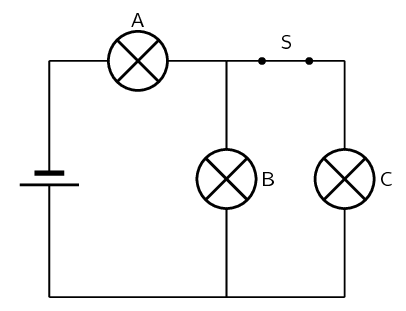Write definitions for each of the following:
-
resistor
-
coulomb
-
voltmeter
|
Previous
Chapter summary
|
Next
18.1 Introduction
|
Write definitions for each of the following:
resistor
coulomb
voltmeter
Draw a circuit diagram which consists of the following components:
2 batteries in parallel
an open switch
2 resistors in parallel
an ammeter measuring total current
a voltmeter measuring potential difference across one of the parallel resistors
Complete the table below:
|
Quantity |
Symbol |
Unit of measurement |
Symbol of unit |
|
e.g. Distance |
e.g. D |
e.g. kilometre |
e.g. \(\text{km}\) |
|
Resistance |
|||
|
Current |
|||
|
Potential difference |
[SC 2003/11] The emf of a battery can best be explained as the \(...\)
rate of energy delivered per unit current
rate at which charge is delivered
rate at which energy is delivered
charge per unit of energy delivered by the battery
[IEB 2002/11 HG1] Which of the following is the correct definition of the emf of a battery?
It is the product of current and the external resistance of the circuit.
It is a measure of the cell's ability to conduct an electric current.
It is equal to the “lost volts” in the internal resistance of the circuit.
It is the power supplied by the battery per unit current passing through the battery.
[IEB 2005/11 HG] Three identical light bulbs A, B and C are connected in an electric circuit as shown in the diagram below.

How bright is bulb A compared to B and C?
How bright are the bulbs after switch S has been opened?
How do the currents in bulbs A and B change when switch S is opened?
|
Current in A |
Current in B |
|
|
(a) |
decreases |
increases |
|
(b) |
decreases |
decreases |
|
(c) |
increases |
increases |
|
(d) |
increases |
decreases |
Bulb A will be brighter than B and C as there is more current flowing through it.
Bulb A and B will be equally bright, but bulb C will not be lit up. (When the switch opens, no current flows through bulb C and bulbs A and B are now in series.)
(a). The current in A decreases, but the current in B increases.
[IEB 2004/11 HG1] When a current \(\text{I}\)is maintained in a conductor for a time of t, how many electrons with charge e pass any cross-section of the conductor per second?
\(It\)
\(\frac{It}{e}\)
\(Ite\)
\(\frac{e}{It}\)
\(\frac{I}{e}\)
\(\frac{I}{e}\)
If you have a circuit consisting of \(\text{4}\) resistors of equal resistance in series and the total voltage across all of them is \(\text{17}\) \(\text{V}\), what is the voltage across each of them?
If you have a circuit consisting of \(\text{4}\) resistors of equal resistance in parallel and the total voltage across all of them is \(\text{17}\) \(\text{V}\), what is the voltage across each of them?
In a circuit consisting of a battery and \(\text{3}\) resistors in series, what is the voltage across the first resistor if the voltage across the battery is \(\text{12}\) \(\text{V}\) and the voltages across the other two resistors is \(\text{3}\) \(\text{V}\) and \(\text{2}\) \(\text{V}\) respectively?
There are \(\text{3}\) resistors in parallel with resistances of \(\text{3}\) \(\text{Ω}\), \(\text{4}\) \(\text{Ω}\) and \(\text{11}\) \(\text{Ω}\). What is the total resistance of the parallel combination?
The same three resistors as above are now arranged in series, \(\text{3}\) \(\text{Ω}\), \(\text{4}\) \(\text{Ω}\) and \(\text{11}\) \(\text{Ω}\). What is the total resistance of the series combination?
The total resistance of two resistors in parallel is \(\text{3}\) \(\text{Ω}\), the one resistor has a resistance of \(\text{5}\) \(\text{Ω}\), what is the resistance of the other resistor?
In a series circuit there are \(\text{3}\) resistors with voltages of \(\text{2}\) \(\text{V}\), \(\text{5}\) \(\text{V}\) and \(\text{8}\) \(\text{V}\), what is the voltage across the battery in the circuit?
In a parallel circuit there are \(\text{3}\) resistors with voltages of \(\text{2}\) \(\text{V}\), \(\text{2}\) \(\text{V}\) and \(\text{2}\) \(\text{V}\), what is the voltage across the battery in the circuit?
|
Previous
Chapter summary
|
Table of Contents |
Next
18.1 Introduction
|